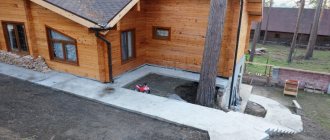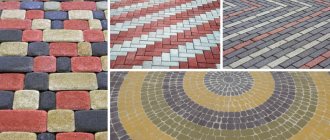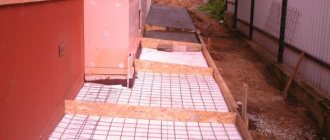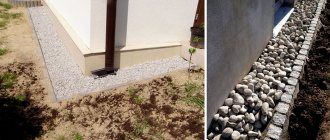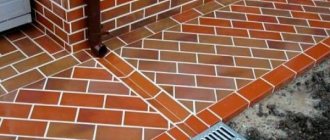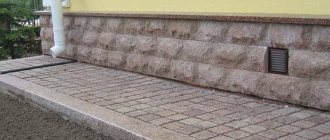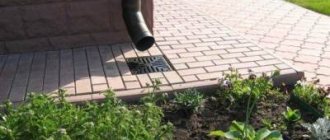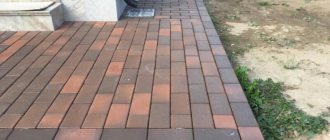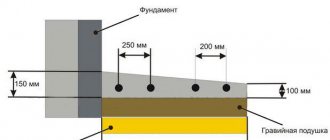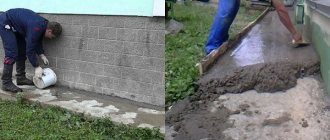The construction of a blind area is an important stage in the construction of any building. It is this that protects the foundation from the negative influence of moisture, plant roots, etc.
The blind area is constructed from various materials, including asphalt. It is of artificial origin and consists of organic and mineral substances that are thoroughly mixed and hardened.
Such a blind area will last for many years. How to build a blind area from asphalt, asphalt concrete and asphalt chips around the house with your own hands, read on.
What kind of coating is this?
Asphalt is a durable coating made from an asphalt or asphalt concrete mixture consisting of bitumen and mineral additives (crushed stone, sand, etc.). This material can be of artificial or natural origin .
The first type consists of two components: bitumen and crushed stone, gravel or sand. The second type is mined in natural deposits. It contains a mixture of bitumen, inorganic and organic compounds.
Asphalt is often called asphalt concrete - it is a monolithic road surface obtained by compacting and laying a special asphalt concrete mixture.
Types of material
Asphalt is , etc.
It is classified according to various criteria, for example, depending on the composition (class 1-3), on the amount of crushed stone and sand (A-D), as well as on the grain size (fine-grained 5-15 mm, medium-grained 25 mm and coarse-grained - 40 mm ).
There are also hot and cold asphalt. The first is used for repairs and does not require special tools and vehicles. The second one requires special equipment and is used for the construction of new roads.
Asphalt can be natural or artificial. One of the latest varieties is asphalt concrete, which has the highest strength characteristics. During the production process, this material is carefully compacted, which significantly increases its quality characteristics.
Another type of asphalt is asphalt crumb . This is a secondary material that is obtained by recycling old road surfaces. Depending on the source material, asphalt crumbs vary in quality depending on the content of bitumen, sand, gravel, etc.
If asphalt concrete is used for the construction of highways, take-off sites, etc., then crumbs are used for surfaces with a low degree of load.
Asphalt crumbs
Why do you need asphalt chips from under the mill?
Laying new asphalt is an expensive operation that requires a variety of materials. To reduce the cost of road construction work, “asphalt crumbs” are used. It is a secondary raw material that is created by grinding the old coating. Using special cutters, the old coating is undermined.
Crushing is carried out in an asphalt granulator, which is simply called a crusher. The installation not only crushes the coating, but also sorts it by size. As a result, the road surface is completely cleaned and prepared for laying new asphalt. After crushing, secondary raw materials are loaded into a dump truck and sent to the next place of work. During crushing, a specialist controls the work process. This will avoid large chunks in the crumbs.
The resulting “asphalt crumb” is a mixture of sand, crushed stone and bitumen residue. Depending on the operating speed of the crushing and screening plant, the size of the crumbs produced will depend. This composition is valued due to the presence of part of the “bitumen”, which envelops the grains and strengthens intergranular bonds. As a result, the quality of raw materials increases and physical and mechanical properties improve. The density of the road surface will be significantly better.
during road construction; when repairing roads at construction sites, in the private sector or garage cooperatives; for filling large holes and major local damage; for strengthening highways; when arranging floors in basements.
Laying asphalt chips is used only in places where there is no serious traffic load.
To obtain good viscosity and resistance to aggressive external factors, concrete or cement is added to the mixture. To improve the quality of the future road surface, a roller is used. Under pressure, strength bonds increase, and the coating becomes more durable and strong. The area of crumbs “can” be additionally asphalted. This will improve performance and extend the service life of the road surface.
- paving of any type.
Tel.
Asphalt crumbs are widely used in road works
Asphalt crumbs are widely used in road works. This is a secondary raw material that is obtained from asphalt concrete during the reconstruction of old roads. Using a special tool - cutters cut the asphalt surface, then process it into small, medium or coarse fractions. It depends on the purpose of the road.
Most often, our company uses this material for landscaping areas around country houses, offices and other buildings. Over the past year alone, we have delivered more than 2,000 m3 of asphalt chips to construction sites. In Moscow, we paving a sidewalk with an area of 600 m2 in a suburban area, where we used asphalt chips as the main material.
The asphalting took place in a short time, since it was necessary to complete it while the weather was warm. We delivered the asphalt crumbs to the site ourselves and began work. After marking the site, first of all, the specialists leveled the territory, then compacted it sufficiently. All vegetation was removed and geotextiles were laid.
The object was delivered ahead of schedule. Such a sidewalk will be reliable and of high quality during operation. The customer is our regular client, so he received good discounts when signing the contract.
What functions does the structure perform?
Asphalt is a hard coating that reliably protects a building from moisture. Compared to pure concrete, this type of material does not require additional processing, which significantly saves money and time.
In addition, asphalt has a number of advantages:
- creating a strong and durable coating;
- simple and easy installation;
- availability of materials;
- ease of care;
- possibility of reuse.
Unlike concrete pavement, asphalt pavement can be used immediately after installation.
Material requirements
The main function of the blind area is to protect the building from destruction. Therefore, the installation of any material must comply with building codes:
Material homogeneity - this indicator indicates the size of the constituent particles of asphalt. The smaller they are, the higher the strength of the product and the easier the installation process.- Separability - the presence of this property indicates the ability of the mixture to maintain the homogeneity of the particles during loading, shipment, transportation and stacking.
- Mobility means that the material can be easily laid using special equipment.
- Formation is the ability of a mixture, when compacted, to transform into a monolithic layer of the required thickness.
Asphalt endowed with the above characteristics is of the highest quality. Installation of the structure requires minimal energy and financial expenditure.
Creation Rules
The asphalt blind area is laid along the entire perimeter of the building and consists of two layers:
- The underlying is the basis for further coating, which also performs a waterproofing function. For this, crushed stone, clay or sand are used. The thickness of the underlying layer should be no more than 20 cm.
- Covering material is a material for covering a blind area, which is selected based on the asphalt requirements described above.
The asphalt is laid on a bed of sand and crushed stone or a mixture of them, the total thickness of which must be at least 15 cm. After which you can begin installing the asphalt covering, 3 cm thick.
How to make a blind area around the house with your own hands
Let's look at an example of making a concrete blind area around a house with your own hands.
After the markings have been set and a trench has been dug, the fertile layer is carefully removed by treating the soil with herbicides. The bottom of the trench profile is sloped towards the outer edge of the structure.
You may be interested in: Choosing the right facade material and color for your home
Clay can be poured onto the trench bottom, which is also compacted on a slope. Then the formwork is placed, the upper edge of which must be aligned with the previously stretched cord.
Further waterproofing of the blind area around the house is done as follows:
- Geotextiles are laid at the bottom of the trench to separate heterogeneous soils;
- Sand is poured, about 20 cm thick, which is carefully leveled with a rake;
- Water it with water and tamp it down;
- When laying surface drainage, a place for pipes and their components is dug in an already compacted base;
- The drainage structure is sprinkled with sand and compacted;
- Lay insulation 5 cm thick;
- Fill the seams between the insulation boards with polyurethane foam;
- An expansion seam is formed;
- Lay a layer of reinforcing mesh;
- Cover all drainage parts with polyethylene;
- Lighthouses are made from wooden boards 20 mm thick;
- The top layer of beacons should be flush with the top of the formwork;
- Fill the trench with concrete solution (at the rate of 250-310 kg of cement per cubic meter);
- Concrete is laid out gradually, starting from the areas between the lighthouses.
Advice!
An hour after the blind area is poured, pour dry cement onto its surface through a sieve. Then, using a hand grater, thoroughly rub it into the surface of the structure.
In order for a concrete structure to “mature” well, it must be watered daily for 2 weeks. After another 14 days, you can remove the formwork, because the blind area is already ready.
Installation technology
The durability of the structure depends on the correct installation, therefore, if you have no or insufficient skills, it is better to contact specialists.
Installation process:
Install bayonets at the required distance from the foundation of the building and stretch a rope between them.
After this, you can start digging a trench, the depth of which depends on the materials used. For example, if the soil is soft, then it can be compacted to the required depth.- A layer of sand or clay is placed at the bottom so that the structure does not go underground. After this, the materials are compacted tightly. If sand is used, it should be wetted to strengthen the layer.
- Install hatches for liquid drainage. They are laid in an asphalt concrete base. The absence of hatches can lead to waterlogging of the soil, resulting in the destruction of the blind area and the foundation of the building. At the point where the blind area and the wall come into contact, an expansion joint 2 cm wide should be made. It can be filled with sand, but it is best to place a waterproofing material (roofing felt or bitumen) there.
- Installing a curb. This is necessary to separate the structure from part of the yard.
- After this, a 15 cm layer of crushed stone or sand is poured, compacted, and asphalt is laid.
When installing a blind area, you must make a slope from the building by 3-5 degrees. This is necessary so that the water does not stagnate, but goes through the hatches to drain the liquid.
The depth of the trench depends on the materials used, usually it is 30 cm. In order for water to fall on the blind area, its width must be 15-20 cm greater than the roof overhang.
From asphalt concrete
The first thing that distinguishes the process of laying asphalt from asphalt concrete is the technique used. In the first case the following applies:
- bulldozer - with the help of which the soil is prepared for coating and a sand-crushed stone layer is applied;
- loader – used for lifting and moving heavy loads;
- grader - used for leveling the soil, as well as clearing the area of bulk materials.
An asphalt paver is used to lay asphalt concrete pavement. The specific type of this technique depends on the volume and complexity of the work. Based on this, the machine can be heavy or light. You will also need a dump truck that delivers the asphalt mixture to the paver.
Asphalt concrete has greater strength and toughness than asphalt . When laying it, the temperature must be maintained at least 130 degrees. If you do not adhere to this rule, the mixture will begin to harden and it will be impossible to level it. Asphalt is laid at a temperature not lower than 100 degrees.
From asphalt crumbs
Asphalt chips are a material formed during the recycling of old asphalt. To obtain good viscosity, concrete or cement is added to the asphalt crumbs.
Asphalt chips are used for arranging paths and other surfaces with minimal load . To improve the strength of the material, laying should be done in two layers, each 10 cm, followed by compaction of each.
Due to the greater compactability of asphalt chips, more material will be required to obtain the required layer thickness.
Before installing a structure made of this material, the underlying soil must be profiled and leveled using a bulldozer. Unlike the general installation technique, it is necessary to lay asphalt chips using shovels, and level and compact them using special equipment.
types, stages of work, repairs
Construction of a correct and reliable blind area for a house is a very important factor for keeping the foundation and walls of the house safe and sound. The blind area of a house, built according to all the rules, will be able to protect the foundation of the building from precipitation and groundwater. The construction of the blind area should be undertaken only after the walls have been erected, when the exterior decoration of the house begins.
This article will provide an accessible and understandable description of how to build a blind area at home, and will also describe methods that are suitable in certain cases. In addition, we will talk about the building materials that are used to make high-quality blind areas at home.
Purpose
The blind area of a house is a layer of waterproof covering that surrounds the entire perimeter of the house. Most often it is made of concrete or asphalt, but other building materials are also used for these purposes. The main task of such a protective layer is to prevent water from entering the foundation, which can lead to its destruction. What other benefits can this type of home protection bring?
Groundwater that gets into the lower layer of the foundation can accumulate in the ground underneath, leading to freezing in the winter. This in turn contributes to frost heaving of the foundation. In addition, if the soil under the foundation begins to swell, this can lead to cracks in the house itself and even to its destruction.
If the soil is over-moistened and the foundation is poorly waterproofed, water can get into the house, and in this case, a blind area around the house allows you to get rid of this problem. A poor-quality blind area will not last long, in addition, the appearance of the house will be ruined.
Important:
The blind area must be done not only for fairly large houses, but also for small buildings. This will create a slope for groundwater drainage and protect the foundation.
Kinds
When making a blind area, you should take into account a number of parameters that must be observed - only in this case will the manufacture of the blind area fully correspond to its purpose.
- Width - determined based on the characteristics of the soil, but most often the universal width is used - 1 meter, but in any case it should be 20 cm wider than the overhang of the roof eaves.
- Length - the blind area should completely surround the house with the exception of the porch.
- Depth - should not be more than half the freezing depth of the soil.
Clay
Perhaps the most ancient type of blind area, clay has been used in construction since time immemorial and has good ductility, fire resistance and water resistance. The construction of a clay blind area is very simple: the fertile layer of soil is removed, after which clay is poured onto a pre-marked area. For the construction of a blind area, it is best to use clay from quarries.
The profile of the blind area should decrease as it approaches the far edge from the wall. To reinforce the clay, gravel or crushed stone is used, which must be compacted - in this case it is possible to obtain a good composite option: the clay is excellent waterproofing, and crushed stone or gravel gives the structure the necessary rigidity, and also prevents the destruction of the blind area by water.
The service life of a blind area made of clay reaches tens of years, but there is still one drawback - if such a structure is regularly exposed to groundwater, the clay will gradually be washed away.
Asphalt
Mainly used in the construction of industrial or commercial buildings. Asphalt is more flexible than concrete, but when exposed to sunlight it can become soft, which causes hydrocarbons to evaporate, which ultimately leads to its destruction.
It is also worth noting that laying asphalt requires special equipment, so filling the blind area around the house with asphalt is a difficult task for an ordinary person
Paving slabs, paving stones
An excellent option when decorating a country house - in this case, the beautiful design of the house and the adjacent area will not be disturbed. In addition to good waterproofing properties, paving slabs have a pleasant appearance, which allows you to decorate the walls of your house in an original way.
But this material has a significant disadvantage - compared to other materials that can be used in the construction of a blind area, paving slabs are quite expensive. The blind area has 2 structural layers - underlying and covering. The bottom layer creates a flat and dense area for placing materials. Sand, clay, and crushed stone are perfect for creating the bottom layer. When to make a blind area around the house? All work on the construction of the blind area is carried out at above-zero temperatures. Before starting work, it is necessary to determine the size of the blind area around the house.
Concrete
The most common type - thanks to the properties of concrete, which is used in the construction of the blind area, you can get the following advantages:
With properly diluted and laid concrete, the blind area acquires increased mechanical strength.
Concrete is not affected by water - it practically does not allow it to pass through, and if additionally treated with a hydrophobic coating, it can become an almost ideal waterproofing barrier.
The technology for performing the work is as follows:
- We mark the future protective strip; for this you can take a width of 1 meter.
- We remove a layer of soil (20 - 40 cm) along the entire perimeter of the building and compact the base. If there are plant roots, we remove them so that they do not subsequently begin to destroy the foundation.
- We build formwork from boards.
- We lay clay on the compacted earth, after which we pour a 10 cm wide layer of sand on top. Compact the resulting layer.
- We spill the top layer with a small amount of water, but not too much because there is clay underneath.
- Pour crushed stone on top. The width of its layer should be 6-8 cm.
- To create rigidity, the blind area should be reinforced. A special rigid mesh with a pitch of 10 cm is suitable for this.
- The blind area, which is located next to the wall base, is equipped with an expansion joint. It provides protection during ground settlement. the width of such a layer is 1 - 2 cm. For these purposes, you can use roofing felt or sand and gravel mixture, as well as sealant and resin.
- For pouring, use concrete grade M 250 or M 300. It should be mixed with sand, small fraction crushed stone and water. When a homogeneous mass is obtained, it should be poured over the reinforced mesh, after which it is compacted and leveled.
- The final step is to cover the concrete with a wet cloth, which must be periodically moistened - this will help prevent the concrete from drying out before it completely hardens, which usually occurs after 7 - 10 days.
Soft
This design is the most modern among all types - the process of creating such a blind area is approximately as follows:
- The soil over the entire area of the future blind area is removed to a thickness of 30 cm, a system of drainage pipes is installed, while maintaining the required slope, a leveling layer is created - for this, sand is poured at least 10 cm thick.
- After which it is moistened and compacted; heat-insulating material is laid on the resulting layer.
- A geomembrane is laid on top of the insulation layer, which must be placed with the working layer facing outwards.
- The last layer of the blind area is created - for this it is recommended to build a border.
- A trench is dug, the level of the curb is determined and the cord is pulled; stones for the curb are placed in concrete, and then covered with soil from the outside.
- The resulting blind area can be covered with beautiful paving slabs, covered with decorative gravel, or a lawn can be planted.
Video
Video about making a concrete blind area with your own hands.
Repair
If various damages appear in the blind area around the house, they should be repaired immediately. Otherwise, precipitation can cause even more damage. Elimination of damage depends on its depth:
- Up to 1 mm - such damage does not require any repair procedures - the crack is erased over time.
- Up to 3 mm - it is necessary to make a cement solution and fill the crack.
- From 3 to 30 mm - eliminated with sealant or concrete mortar.
- For more significant damage, it is necessary to expand the blind area and fill it with a new solution of concrete or cement.
Conclusion
Now you know why a blind area is needed and what steps should be followed when making a blind area. Arranging a blind area for a house is an important stage in the construction of a house. Moreover, this design works in conjunction with other parts of the building.
A well-made structure cannot correct deficiencies in the construction of the foundation. And vice versa - a well-made foundation will not improve the protective properties of a poorly made blind area. Agree, arranging a blind area around the house is not that difficult. This does not require special tools or special materials. To do this, you just need the desire to work and make high-quality protection for your home yourself.
osnovapoddom.ru
Common Mistakes
The main errors due to which the blind area does not perform its functions include:
- A lack of components in the asphalt mixture or an excess of water leads to the appearance of cracks in the structure and its rapid destruction.
- The use of lower density soil when backfilling, loam instead of clay and sand instead of sandy loam - this leads to the fact that even after compacting the layers, water still seeps and is absorbed into the soil, due to which it increases in size, and the asphalt structure is destroyed.
- Laying asphalt concrete directly on leveled ground, without cushion or expansion joints. This will lead to the fact that after some time the structure will become unusable, and the foundation will begin to quickly collapse under the influence of heaving soil.
- The absence of gutters will cause water dripping from the roof to begin to soak into the soil. Its excess will lead to the destruction of the blind area.
It is very important to follow all the rules for constructing a structure, while paying special attention to the quality of building materials. You shouldn’t skimp on them so that you don’t have to spend even more money to correct errors.
Scope of application
Asphalt crumbs are affordable and cause less harm to the environment.
That is why it is used quite widely. This material is indispensable in almost all areas of economic activity:
- This material is known among gardeners and summer residents. With the help of asphalt chips, paths and parking lots are built. This option is significantly more profitable than laying tiles.
- It is used for asphalting secondary and suburban roads. Installation is completed in the shortest possible time. This requires minimal surface preparation. Optimum resistance to adverse weather conditions is guaranteed. But such a coating wears out quickly, so it is not suitable for roads of the first category.
- For the construction of basketball and football fields, as well as training complexes. Provides excellent shock absorption. The coating can be laid on absolutely any terrain.
- For the construction of small houses and garages. It is possible to build a blind area from asphalt chips faster and easier. This option is more affordable than a concrete structure. Asphalt chip flooring is an excellent solution for a garage.
Advantages and disadvantages of application
Asphalt is a hard surface that does not allow water to pass through and therefore does not require additional treatment.
In addition, the material has other advantages:
- high strength;
- flat surface of the blind area without joints;
- ease of installation and subsequent maintenance;
- availability of materials;
- can be reused.
Unlike concrete, asphalt pavement can be used for its intended purpose immediately after compaction. The main disadvantage of the material is the release of harmful substances under the influence of sunlight, as well as the need for special equipment during the installation of the structure.
Cost of materials and 1 m² of installation
The cost of building a blind area depends on many factors; the chosen design and scope of work play a big role here .
The price is also affected by the cost of the materials used, for example, the cost of asphalt per 1 m2 is from 2,500 rubles. and higher, asphalt crumb is slightly cheaper, from 1500 to 1800 rubles per 1 m2.
When arranging a turnkey blind area, the cost of the work includes preparing the area for digging a trench, marking, laying layers of structure, as well as unforeseen expenses (for example, if, due to the characteristics of the blind area or soil, it is impossible to approach it closely).
If you do not have special knowledge and equipment, it is better to hire specialists to install the asphalt blind area . For example, in St. Petersburg, the basic cost of installation of a turnkey structure varies from 1,900 rubles per 1 m2, and also in Moscow, prices are practically the same.
In Yekaterinburg, installation of an asphalt blind area without insulation will cost at least 1,600 rubles per 1 m2, and with insulation – from 2,250 rubles. Asphalting in Krasnodar ranges from 1,420 rubles and above.
In each case, the price for the work is calculated individually . What matters here is the complexity of the project, the volume and location of the object, as well as the need for insulation, waterproofing, etc.
Important and useful information about materials for the construction and finishing of blind areas around the house is presented in this section.
its functions and construction technology.
The constructed house must be safe and durable. To perform these functions, it must be protected. One of the defenders of the structure is the blind area built around the house.
Purpose of the blind area of the house
- Protection of the foundation from melt, rain and waste water.
- and ground floor.
- Creation of a pedestrian zone around the building.
- Decorating the exterior of the house.
Types of blind areas
The service life of the blind area must coincide with the operational period of the structure, so you need to carefully select the base of the blind area and the material for its arrangement.
Depending on the type of base, the blind area around the house can be of several types:
- With a simple or complex design. The second type involves the construction of a structure of several layers with significant depth and a system for draining water of various origins.
- With or without the use of waterproofing materials and insulation. The construction of a blind area on problematic soils requires the presence of a waterproofing thermal insulation layer.
- With or without pouring the top concrete layer.
- With different types of finishes. Various finishing materials can be laid on top of the blind area, which will make the appearance of the building more attractive. For this purpose, tiles, paving stones, porcelain stoneware or natural materials are used.
- With hidden or open surface. The blind area can be lined with a layer of turf, which makes it invisible to prying eyes.
When choosing the base of a blind area, it is important that the structure not only has an attractive appearance, but is also reliable and durable.
To create a blind area around the house, you can use various materials. Among the popular types of design are the following:
- A concrete blind area is the most common way to protect a house and foundation from water. Concrete has been tested by many generations of builders, so it is considered the most reliable material. In addition, the process of pouring a concrete blind area is not complicated, which allows you to do the work yourself.
- The asphalt concrete blind area also reliably protects the structure. But using this material requires special equipment. The thing is that maintaining the working condition of asphalt requires a temperature of 120 0, and great efforts must be made to lay it gently.
- A blind area made of ceramic tiles makes the space around the house more attractive. However, in order for the coating to perform all its functions, a high-quality material is required that can withstand the aggressive influence of the environment.
- Paving slabs have been used for arranging blind areas relatively recently. Despite this, the material can act as a reliable protection for the house from melt and rain water.
- The use of natural stone for cladding structures is losing its popularity due to several reasons. For example, complex installation, inconvenient delivery, and the presence of proper drainage.
- Soil for arranging a blind area is used very rarely, although it provides many advantages. The soil blind area can be sown with lawn grass and decorated with flower beds and flower beds. The complexity of this design lies in the use of geotextiles with which the blind area is covered. This limits movement around the structure.
We make a blind area with our own hands
- The area where the work will be carried out is cleared of excess vegetation.
- Markings are made along the entire perimeter of the building. A distance equal to the width of the blind area is measured from the walls of the house. Wooden stakes are installed in the corners and a construction cord or regular rope is pulled.
- Adhering to the markings, dig a trench with a shovel. Its depth is determined depending on climatic conditions and soil characteristics on the site. Excavation is carried out with a slight slope, approximately 2-3 0.
- The bottom of the dug trench is carefully compacted.
- A damper layer of polyurethane film is laid along the walls of the house. This will protect the blind area and foundation from destruction when exposed to certain natural phenomena.
- The bottom of the trench is covered with a layer of waterproofing material.
- Sand is poured over the waterproofing in a layer of 10-20 cm. The surface is leveled and compacted. For maximum compaction, the sand layer is watered.
- Cover with a layer of gravel and fine crushed stone.
- Everything is carefully leveled.
